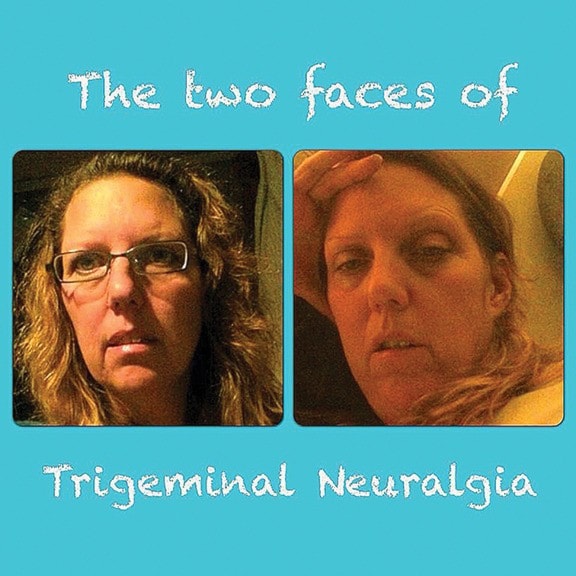“You don’t know me, but perhaps you’ve seen me. I’m the woman bound up in a head scarf like it’s the middle of winter, but on a beautiful summer’s day. I’m the woman in the store you witnessed drop to her knees, screaming in obvious agony, then stand and walk on minutes later like nothing happened. I am the woman in the store looking like she just woke up — no makeup and hair all akimbo — and you wonder why I’m not embarrassed to be seen like that. I am the woman who looks ‘normal’ that just stepped out of a vehicle sporting a ‘disabled’ sticker, and you wonder if I’m lazy.”
That woman’s name is Lee Shanks.
The 51-year-old Shawnigan Lake wife and mother has trigeminal neuralgia, or TN, and lives much of her life in quiet agony.
The Mayo Clinic describes trigeminal neuralgia as “a chronic pain condition that affects the trigeminal nerve, which carries sensation from your face to your brain. If you have trigeminal neuralgia, even mild stimulation of your face — such as from brushing your teeth or putting on makeup — may trigger a jolt of excruciating pain.”
Shanks wants the Cowichan Valley — and the world — to know about the third anniversary of International Trigeminal Neuralgia Awareness Day, today, Oct. 7. Landmarks and buildings around the world will light up in teal for the cause.
It’s not known what, if any, landmarks on Vancouver Island will show their support by lighting up with teal on that day but in the Lower Mainland, you will see B.C. Place Stadium, Telus Science World, Jack Poole Plaza, the Canada Place Sails, Vancouver Convention Centre, Port Metro Vancouver, Telus Science Centre, Lafarge Fountain in Coquitlam, and City Hall in Port Moody lit up.
Shanks said she’s going to start fighting for a dedicated awareness day for the relatively rare condition because the more people know about it, the more people know they don’t have to suffer alone.
“It is literally known as the worst affliction known to medical science,” she said last week. “It’s kind tough,” she added in a giant understatement. “People with TN live in constant pain. There’s never a day where I’m not in pain and I’ve been like that for years.”
A former journalist turned government communications manager is now on permanent disability and copes day-to-day as best she can with what they dub the “suicide disease”, raising two boys ages six and 13 and caring for her four-year-old autistic great nephew on a small farm with ducks, chickens, geese, dogs, cats and a hamster. Her husband has been a pillar of strength for years, oftentimes doing much of the heavy lifting.
“I parent from the couch sometimes,” she admitted.
But most people don’t know Shanks is even suffering. And while she goes through “good phases” of time, other times are unbearable.
These days she’s in a good spot and is able to participate in her young family’s lives more instead of being a spectator.
Other days are not as good.
“It manifests itself in many different ways from feeling like my jaw is caught in a vice clamp to feeling like someone is stabbing me in the ear or trying to cut out my eye with a paring knife,” she said. “I can get all of those or one of those or some of those and some I get on both sides of my face.”
The worst, she said, is the classic TN symptom, it feels like a lightning bolt shooting behind her left brow.
“That’s the one that can knock me to my knees. Everything else I can sort of fake my way through,” she said. “And I wish I were exaggerating. But I’m not. TN affects the nerves in your face, essentially sending your brain the wrong message. A mere kiss can be excruciating. Putting on makeup or brushing my hair is not always an option. Neither is brushing my teeth. Having a shower can feel like standing in acid rain.”
One of the misconceptions about trigeminal neuralgia is that it only affects older people. While it’s more likely to occur in women and in people over 50, young people are suffering too.
Shanks said her first “lightning bolt” struck her when she was 23.
“In hindsight, they actually suspect it started in my teens,” she said.
Currently, there are courses of pharmacology treatment, surgical intervention, alternative medical treatment, botox, nerve blocks, implanted nerve stimulators, supplements, diet and individual choices of distraction to help alleviate the pain.
But none of them are permanent.
None of them are a cure.
“If people have ongoing facial pain that they’re having difficulty getting diagnosed, whether it’s related to dental issues or their ears or their eyes, really push for a neurological assessment because TN is misdiagnosed so often and the medical community knows very little about it,” Shanks said. “Quite often we find ourselves educating our doctors.”
Bolstered by a strong sense of community online through various Facebook support groups, Shanks said she and other sufferers are able to not just support each other but educate each other about different approaches that different doctors are using that they may never have heard of otherwise.
The number one thing about being part of that online support network is that it lets people know they are not alone.
“That is huge when you’re fighting something that is so debilitating,” she said. “We’re called TN Warriors,” she said. “We battle every day. That’s our battle. And we have life in between.”
Visit www.tnnme.com to learn more.
